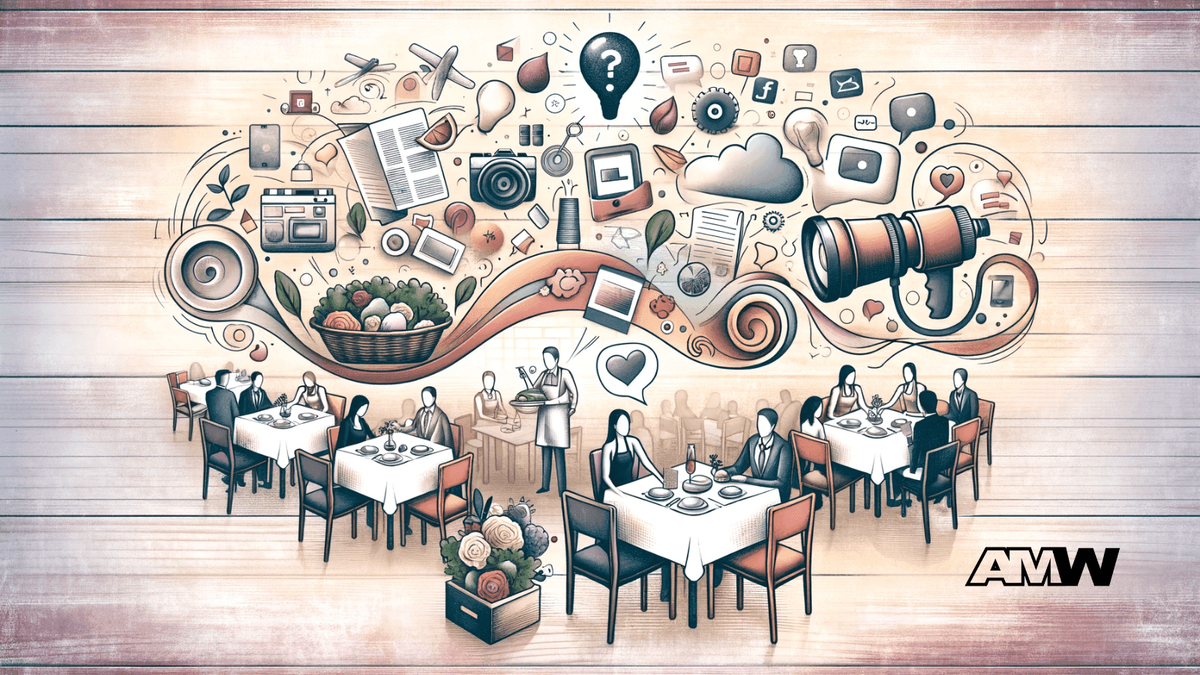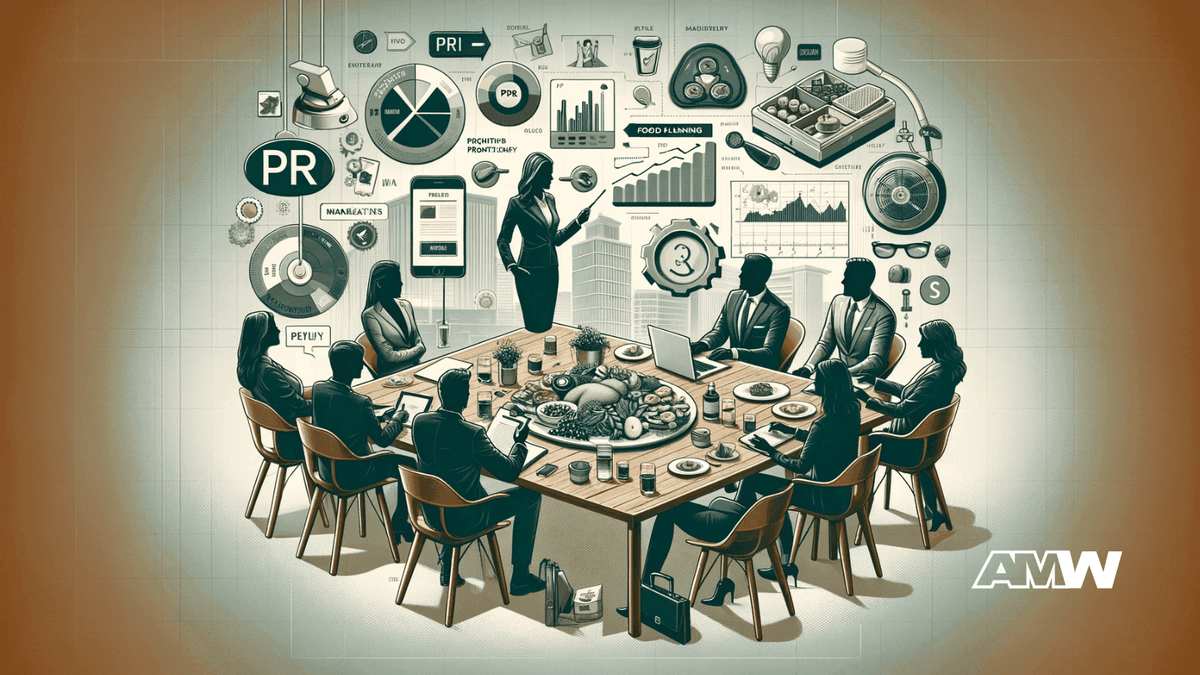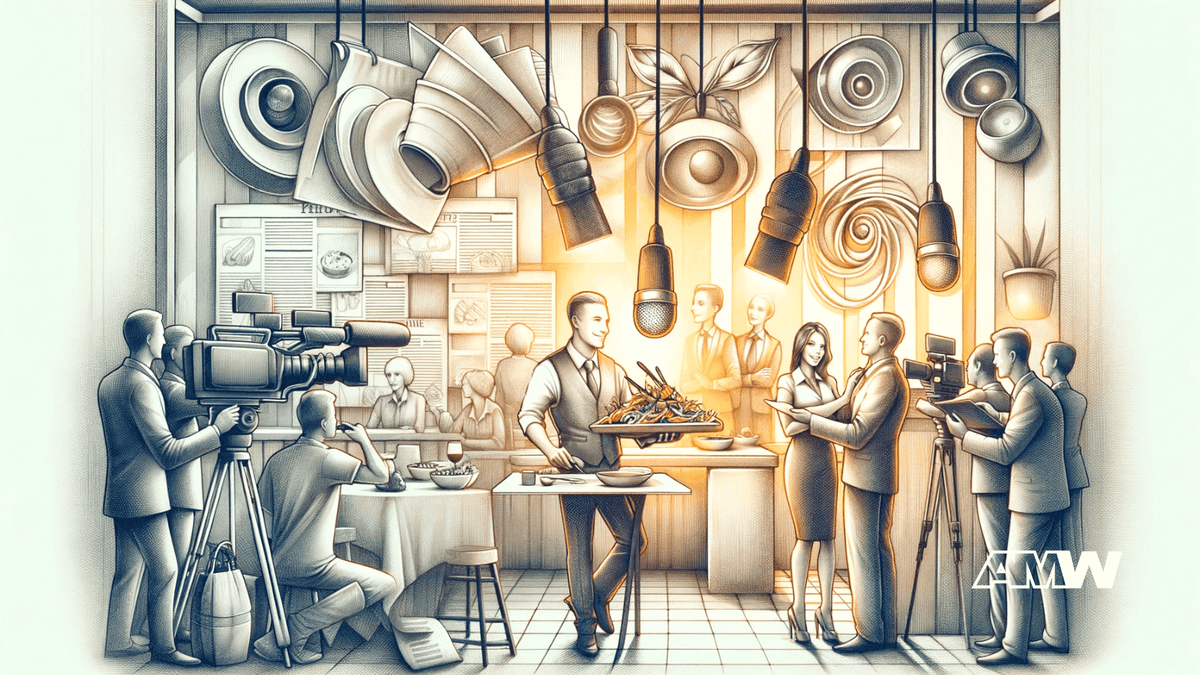Food PR Strategy Guide: Building Successful Campaigns in Food and Beverage PR

Public Relations (PR) in the food and beverage industry is an intricate blend of art and strategy involving creating and maintaining a positive image among consumers and media outlets for food and beverage companies.
Quick Summary
In the food and beverage industry, Public Relations plays a critical role in shaping brand narratives and enhancing consumer engagement. PR professionals craft compelling stories that resonate with sensory experiences, while leveraging media relations and influencer partnerships to maximize visibility. They also emphasize event planning and effective crisis management to maintain brand reputation. With ongoing trends towards sustainability and technology integration, successful food PR strategie
Unlike other industries, food PR must resonate with the sensory experiences of the audience, making it unique. It's not just about conveying information; it's about crafting stories that appeal to people's tastes, smells, and cultural connections with food and beverage choices.
PR professionals navigate the complex food ecosystem in this specialized field, focusing on how food and beverage products are perceived in the market. They work tirelessly to increase visibility and market share for their clients, often employing innovative content creation and influencer marketing strategies. The goal is to build a narrative that not only promotes a product but also weaves it into the lifestyle choices of the target audience.
Ready to Grow Your Business?
Get a free consultation and custom strategy tailored to your goals.
This delicate process of shaping public perception involves deeply understanding the food and beverage landscape. PR experts must be attuned to the latest culinary trends, dietary movements, and consumer preferences. They must also be adept at crisis management, ready to handle any challenges, such as food safety concerns or negative reviews, with tact and professionalism.
Moreover, food PR is about creating and sustaining relationships – with food critics, bloggers, journalists, and influencers. These connections are vital for securing media coverage, whether in traditional print publications, online platforms, or social media channels. By fostering these relationships, PR professionals can amplify their clients' messages and reach a broader, more engaged audience.
PR in the food and beverage industry also involves event planning and execution – from press launches for new products to experiential marketing events and tastings. These happenings allow brands to showcase their products in a controlled, immersive environment, creating direct engagement with their target audience.
Overall, the role of PR in the food and beverage industry is multifaceted and dynamic, requiring a blend of creativity, strategic thinking, and a thorough understanding of the culinary world. PR professionals in this sector are not just promoting products; they are telling stories, building brands, and creating experiences that resonate with consumers personally.
Through their efforts, they contribute significantly to the success and growth of food and beverage companies in a highly competitive market.
The Need for PR: Why Do Restaurants Need Public Relations and Media Coverage?

The role of PR in shaping a restaurant's reputation cannot be overstated. Effective public relations strategies can catapult a restaurant from obscurity to fame, significantly impacting customer engagement and sales. For instance, when a PR agency secures media coverage for a restaurant, it elevates the establishment's profile, attracting new customers and retaining existing ones.
Case studies of successful restaurant PR campaigns often highlight the importance of ongoing media relations and event marketing. For example, a well-executed launch event covered by critical media can create a buzz that resonates long after the event. This press coverage is essential for restaurants to stand out in a competitive market.
The Role of a PR Firm: What Exactly Does a PR Firm Do for the Food Industry?

A PR firm specializing in the food industry offers services tailored to meet food and beverage brands' unique needs. These services range from strategic consulting and branding to media relations and crisis communications. A PR firm specializing in the food and beverage sector can create strategies aligning with a brand's vision and goals.
Partnering with a PR firm offers numerous benefits to food and beverage companies. These agencies have established relationships with media and influencers, expertise in crafting compelling stories, and the ability to navigate the ever-changing landscape of consumer preferences and trends. Their strategic approach helps businesses increase their visibility, strengthen their brand image, and drive sales.
Crafting a Food PR Strategy: Key Elements to Consider

Developing a successful Food PR strategy requires understanding the food and beverage industry, the brand's unique position in the market, and the target audience's preferences. A comprehensive strategy should integrate digital and traditional PR methods, ensuring a consistent message across all platforms.
Critical elements of a Food PR strategy include:
- Identifying the right media outlets for the brand.
- Developing unique and engaging stories that resonate with the target audience.
- Using influencer marketing for a wider audience.
It is also essential to focus on building relationships on an ongoing basis with media and customers, as this fosters trust and loyalty.
Adequate Food and Beverage PR is about more than just promoting products; it's about telling a story that connects with consumers personally, creating a lasting impression in a crowded and competitive marketplace.
Ready to Grow Your Business?
Get a free consultation and custom strategy tailored to your goals.
Storytelling in Food PR: Creating a Compelling Brand Narrative

The essence of Food PR lies in storytelling. It's about creating a narrative that connects food and beverage brands with their audience on a deeper level. This storytelling goes beyond product promotion; it's about crafting a tale embodying the brand's values, heritage, and vision.
To craft these engaging stories, it's essential to understand what makes your brand unique. What is the history behind your food products? What are the values that drive your beverage company? Answering these questions can lead to authentic and relatable stories. Additionally, incorporating elements of your brand's lifestyle can make your narrative more appealing.
Remember, a good story in Food and Beverage PR is one that consumers can see themselves in.
Leveraging Social Media for Food PR

Social media has become an indispensable tool in Food PR. It offers a platform to share your brand's story, engage with consumers, and increase visibility. The key to success is selecting platforms that match your target audience and brand voice.
One effective strategy to showcase your food and beverage products is using visually appealing content such as high-quality images and videos. Interactive content, like polls or behind-the-scenes glimpses, can also boost engagement. For instance, a beverage brand might share a video of the brewing process, inviting viewers into their world.
Successful social media campaigns often involve influencer partnerships, leveraging their reach to gain credibility and wider audience attention.
Media Relations in the Food Industry

Building and maintaining relationships with food journalists and bloggers is a cornerstone of successful Food and Beverage PR. These media relations are crucial for getting your story out there. To establish these relationships, it's essential to understand the media landscape and the specific interests of journalists and bloggers in your niche.
When pitching food-related stories, tailor your pitches to align with the interests and styles of the journalists you're targeting. Personalization is key. Offer them unique angles or exclusive insights into your food and beverage products. Remember, a well-crafted pitch can lead to valuable press coverage, enhancing your brand's reputation and reach.
Event Planning and Promotion in Food PR

Events are a powerful way to bring your food and beverage brand to life. Whether it's a product launch, a tasting event, or a cooking demonstration, events offer a unique opportunity for customers to experience your brand firsthand.
Effective promotional strategies are essential to maximize the impact of these events, including leveraging social media to create buzz, sending press releases to media outlets, and engaging with influencers to broaden your reach. Ensuring that the event aligns with your overall Food PR strategy and brand message is also essential.
A well-planned event can significantly increase visibility for your food and beverage company, creating memorable experiences that resonate with both media and consumers.
Crisis Management in Food PR

Crisis management is critical in public relations, especially in the food industry, where consumer health and brand reputation are at stake. Preparing for and effectively managing PR crises requires a comprehensive plan that includes proactive communication, quick response strategies, and transparent messaging.
A fictional example might involve a beverage company facing a quality control issue. A successful crisis management approach would involve:
- Immediate acknowledgment of the problem.
- Clear communication about the steps being taken to address it.
Ready to Grow Your Business?
Get a free consultation and custom strategy tailored to your goals.
- Consistent updates to the public and media outlets.
This approach helps maintain trust and minimize damage to the brand's reputation.
Measuring the Success of Your Food PR Campaign

Evaluating the effectiveness of a Food PR campaign is crucial for understanding its impact and guiding future strategies.
Tools like media monitoring services, social media analytics, and customer feedback surveys are invaluable in measuring PR effectiveness. These tools provide insights into media coverage, audience engagement, and overall brand sentiment.
Adapting strategies based on feedback and results is essential. For instance, if a specific type of content creation resonates well with the audience, a food and beverage company might focus more on similar content in future campaigns.
Regularly reviewing and adjusting strategies ensures that Food PR efforts remain aligned with changing market dynamics and consumer preferences.
Future Trends in Food and Beverage PR

As we delve further into the 21st century, the landscape of food PR is being reshaped by several key trends and innovations.
Alongside the increasing use of technology and online platforms for content distribution, there is a noticeable shift towards more personalized and data-driven campaigns. AI and machine learning in public relations allow for more targeted and efficient messaging, enabling brands to reach their ideal consumers precisely.
Another significant trend is the integration of technologies like AR and virtual reality (VR) in marketing campaigns. Food and beverage brands can use these technologies to showcase their products, tell stories, and create memorable consumer experiences.
Sustainability and ethical practices are also central themes in food and beverage PR. Consumers now expect brands to prioritize environmental and social issues in their communication and activities. This shift leads to more transparent and responsible marketing practices, which appeal to consumers' ethics and foster long-term loyalty.
The growing influence of influencers and content creators in the digital space continues to be a vital aspect of food and beverage PR. Brands increasingly collaborate with these online personalities to leverage their large followings and credibility.
This approach enables brands to leverage the influencer's established trust and rapport with their audience, extending their reach and impact.
Conclusion

In conclusion, Food and Beverage PR, or in other words Culinary PR, is a rapidly evolving field driven by technological advancements, changing consumer behaviors, and a growing emphasis on health, wellness, and sustainability. For businesses in this sector, staying abreast of these trends and adapting their strategies is crucial for sustained success.
By partnering with skilled PR professionals and agencies and leveraging the full spectrum of services and expertise they offer, food and beverage brands can effectively navigate this dynamic landscape. Through storytelling, digital platform management, and innovative advertising, PR can impact a brand's perception and reception.
Ultimately, the key to thriving in the competitive world of food and beverage is to remain adaptable, forward-thinking, and always attuned to consumers' evolving needs and desires. By doing so, brands can achieve success in the present and lay a strong foundation for future growth and development.
Ready to Grow Your Business?
Get a free consultation and custom strategy tailored to your goals.
Frequently Asked Questions
How do you develop an effective food PR strategy for a new restaurant or food brand?
An effective food PR strategy starts with identifying your unique brand story and target audience. Key elements include selecting relevant media outlets, developing authentic narratives that resonate with consumers, and integrating both digital and traditional PR methods. Build relationships with food journalists, bloggers, and influencers in your niche. Create a content calendar featuring high-quality visuals, behind-the-scenes content, and seasonal campaigns. Focus on consistent messaging across all platforms while highlighting your brand's values, heritage, and what makes your food products distinctive in the competitive marketplace.
What does a food and beverage PR firm do differently from general PR agencies?
Food and beverage PR firms specialize in the culinary industry's unique challenges and opportunities. They maintain established relationships with food journalists, culinary influencers, and industry publications. These agencies understand food trends, dietary movements, and consumer preferences specific to the culinary world. They offer specialized services like product launch events, tasting experiences, crisis management for food safety issues, and sensory-focused storytelling that appeals to taste, smell, and cultural food connections. Their expertise includes navigating food regulations, seasonal marketing, and creating campaigns that integrate lifestyle choices with food products.
How can restaurants use social media effectively for food PR campaigns?
Restaurants should focus on visually appealing content featuring high-quality food photography and behind-the-scenes videos. Create interactive content like polls, recipe shares, and live cooking demonstrations to boost engagement. Partner with local food influencers and encourage user-generated content through branded hashtags. Share your restaurant's story, highlight seasonal ingredients, and showcase chef personalities. Post consistently during peak dining times, respond promptly to comments, and use location-based features to attract local customers. Leverage platform-specific features like Instagram Stories, TikTok trends, and Facebook events to maximize reach and engagement.
What are the best practices for pitching food stories to journalists and bloggers?
Research journalists' previous coverage and writing style to personalize your pitch. Lead with a compelling hook that ties into current food trends or newsworthy angles. Include high-resolution images, chef backgrounds, or unique ingredient stories. Offer exclusive access, such as recipe reveals or behind-the-scenes interviews. Keep pitches concise with clear subject lines and send during business hours. Provide multiple story angles and be flexible with timing. Follow up professionally but avoid being pushy. Build relationships by engaging with journalists' content on social media and attending industry events where you can connect in person.
How do you handle food safety crisis communications in restaurant PR?
Address food safety crises immediately with transparency and accountability. Prepare a crisis communication plan in advance with pre-approved messaging templates and designated spokespeople. Issue public statements acknowledging the situation, outlining corrective actions taken, and demonstrating commitment to customer safety. Coordinate with health authorities and legal teams before making public announcements. Use multiple channels including social media, website updates, and direct customer communications. Provide regular updates on investigation progress and preventive measures implemented. Focus on rebuilding trust through consistent actions, third-party safety certifications, and ongoing transparent communication about food safety protocols.
What types of events work best for food and beverage PR campaigns?
Product launch events with tastings allow direct consumer engagement and media sampling opportunities. Pop-up experiences create buzz and exclusivity while showcasing brand personality. Chef collaborations and cooking demonstrations provide educational content and expert credibility. Seasonal events tied to holidays or local festivals generate timely media coverage. Behind-the-scenes brewery or kitchen tours offer authentic storytelling opportunities. Food pairing events with wine, beer, or cocktails create sophisticated experiences. Charity partnerships and community events build positive brand associations. Virtual cooking classes and online tastings expand reach beyond geographic limitations while maintaining interactive engagement.
How do you measure the success of a food PR campaign?
Track media coverage through earned impressions, article mentions, and share of voice compared to competitors. Monitor social media metrics including engagement rates, follower growth, user-generated content, and branded hashtag usage. Measure website traffic increases, particularly from referred media coverage and social channels. Assess sales data correlation with campaign timing and geographic coverage areas. Conduct sentiment analysis of brand mentions and customer reviews. Track reservation increases for restaurants or retail placement for food products. Calculate PR value equivalency and cost per impression. Survey brand awareness before and after campaigns to measure perception shifts and recall rates.
Related Articles

PR Partnership: How to Build a Strong PR Collaboration
A PR partnership can bring substantial value to brands looking to grow their reach and build a strong brand presence. By collaborating with the right PR partner, organizations can benefit from inc

What is a Public Relations Firm?
Creating an effective public relations (PR) strategy may benefit from the work of a PR firm, which could play an important role in shaping a brand's image and managing communication between the organi

What are PR Campaigns? A Guide to a Successful Public Relations Campaign
Public Relations (PR) stands at the forefront of shaping how organizations communicate with their public. More than just managing a brand's image, PR orchestrates the strategic communication proce